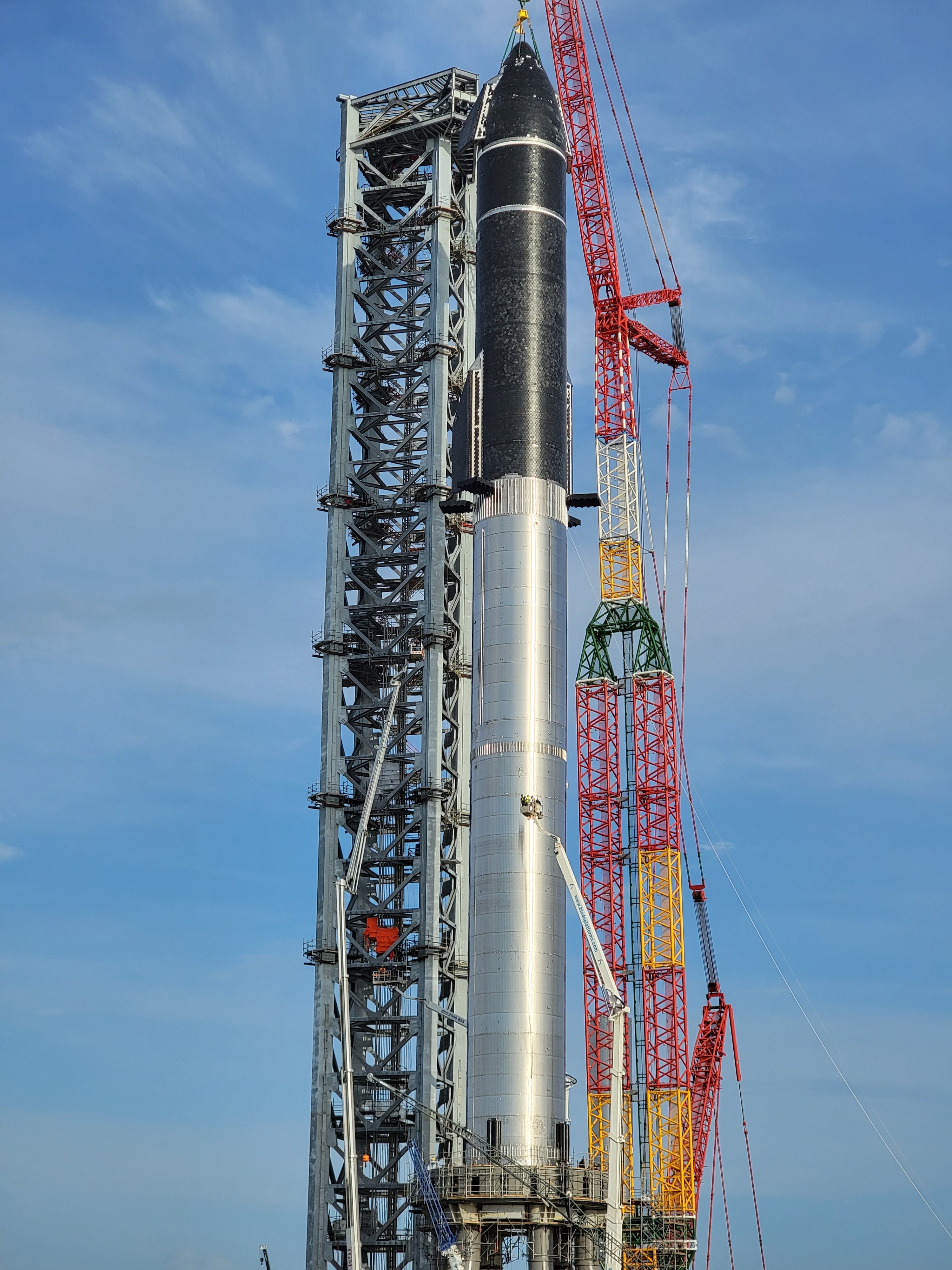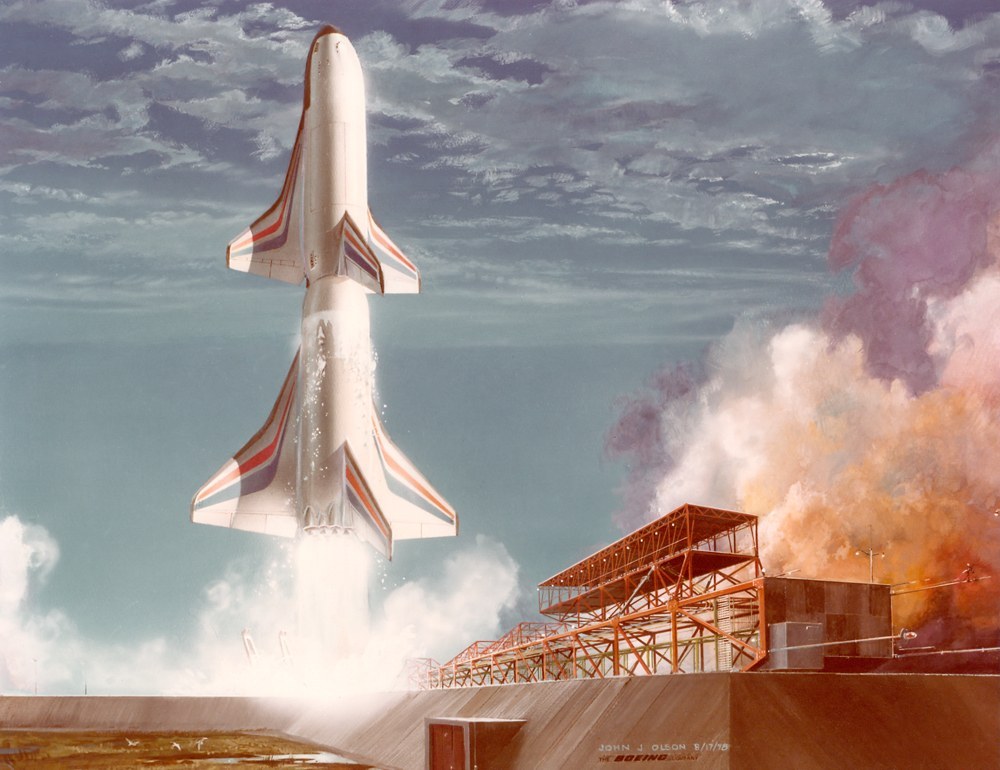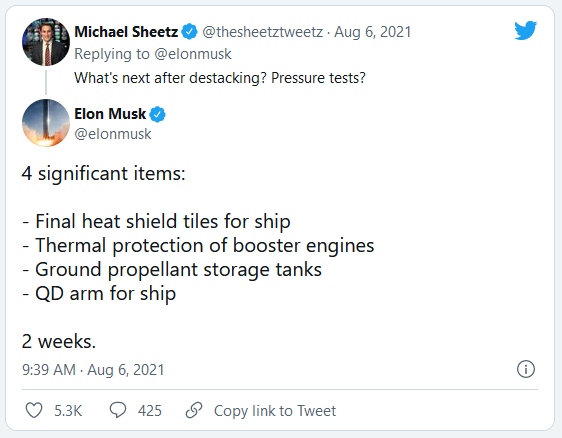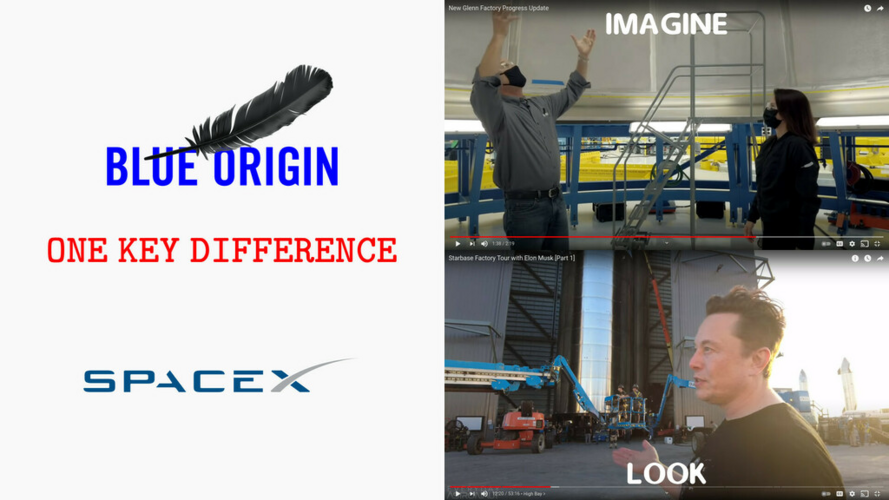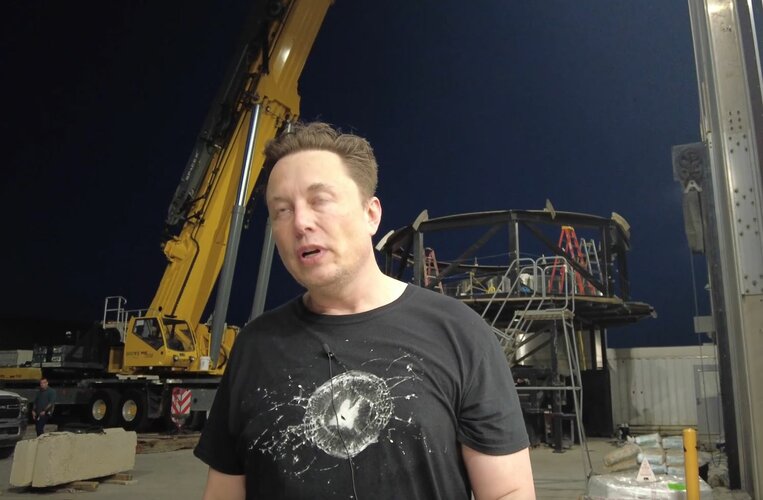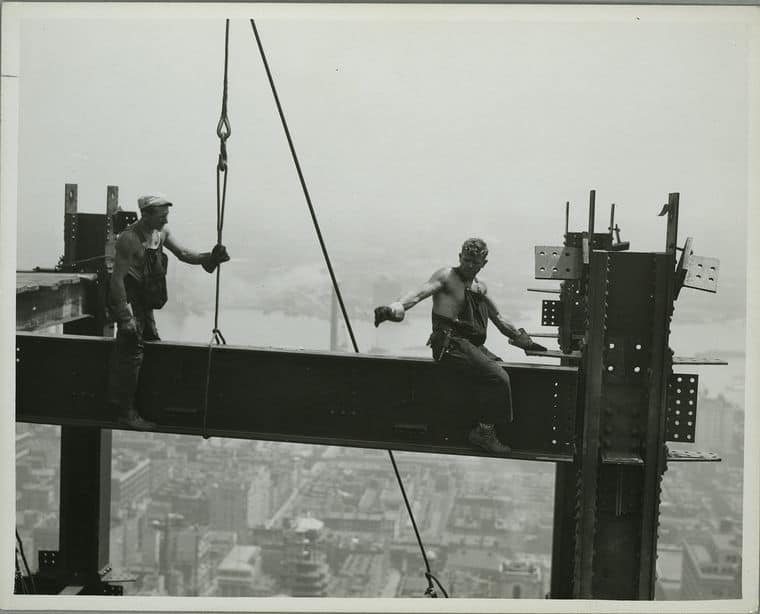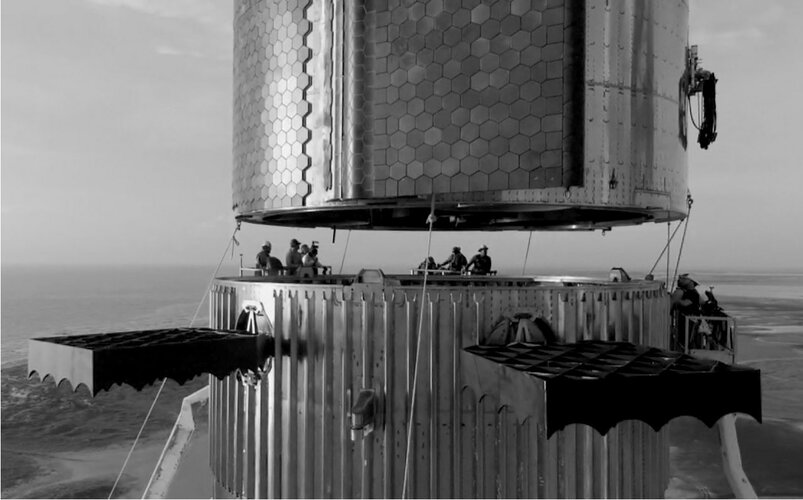You are using an out of date browser. It may not display this or other websites correctly.
You should upgrade or use an alternative browser.
You should upgrade or use an alternative browser.
SpaceX (general discussion)
- Thread starter FutureSpaceTourist
- Start date
- Joined
- 4 July 2010
- Messages
- 2,514
- Reaction score
- 3,091
This was a fit-check, no reason to delay that until the TPS installation reached 100%. Plenty of more work ahead before final stacking and launch, and plenty of time to finish the tile job.Just again a question to the missing tiles!?
Will they be added when both are stacked or do they leave them (I don't think so)?
I have to admit, I don't really understand this procedure at the moment ... why not finish SN20 first and then stack both?
GOOD GRIEF !! It is REAL at least. REAL.i hear Bezos screams: SMITH !!!
Behold the biggest Rocket ever build
One rocket to rule them all...

Unbelievable. Only five years since Musk disclosed his plans - September 2016.
- Joined
- 3 June 2011
- Messages
- 18,335
- Reaction score
- 12,233
Attachments
- Joined
- 3 June 2011
- Messages
- 18,335
- Reaction score
- 12,233
Because it was just a fit test and they still have a lot of work to do.Why did they removed the starship from the booster ?
And those engines will have 230 tonnes of thrust with Raptor 2And that's just a prototype with 29 engines. The production version is to have 33 engines with more than double the liftoff thrust of the Saturn V.Holy ****
I was thinking why did they use a smaller rocket to transport the tip ( StarShip) to the bigger one...
Oh man, this is amazing

jeffb
ACCESS: Top Secret
- Joined
- 7 October 2012
- Messages
- 1,280
- Reaction score
- 1,937
I'm not seeing the significance of 27 engines across three boosters vs if they were in a single booster. If anything I'd think that would make an engine failure MORE likely as there are more interfaces. Lastly, the booster can be static fired. It's not like it's going to get five feet off the pad and go TU. It will be well-tested before the first flight.
The issue is that you can get coupling between the noise and vibration of engines firing simultaneously and the flow of propellant through the feed lines. It can lead to effects in the propellant lines that are sort of analogous to a combustion instability in the sense that they can lead to instabilities in the propellant feed that can lead to pogo effects. Pogo effects can cause the loss of engines or in worst cases scenarios, tear the structure apart.
These issues have all already been resolved in the Falcon 9 boosters. Connecting three such boosters together as in the Falcon Heavy can lead to some cross-over of noise/vibration effects, but it's typically not as big an issue because dealing with the effects of reflected noise and it's impacts on individual boosters have already largely been dealt with.
Naturally, the likelihood of unexpected vibration coupling effects goes up with the number of engines and the complexity of the plumbing. You have to either model their effects accurately, or build propellant systems that can absorb/compensate for those effects. You need to make sure conditions don't change substantially if you loose engines etc.
And then of course they do static tests, to make sure they haven't missed anything and that the booster isn't going to tear itself apart just after it leaves the pad.
- Joined
- 13 August 2007
- Messages
- 8,445
- Reaction score
- 10,996
That was down fall of N1 rocket (also had bad engines)The issue is that you can get coupling between the noise and vibration of engines firing simultaneously and the flow of propellant through the feed lines.
Noise is serious issue, the Saturn V was loud, very loud you could hear the rocket 10 miles away at 128 Dezibel.
But that was nothing against the Shuttle SRB, who were much louder, so loud that sound damage the launch pad !
NASA had to modified there Saturn V water deluge system to fit Shuttle launches to damping the sound
How SpaceX will damping the sound for Superheavy blast off ?
i guess that they will use water in some way either deluge system in Launch platform
or flood the ground under Launch platform
- Joined
- 9 October 2009
- Messages
- 21,969
- Reaction score
- 13,616
It is possible that they might try to use some form of electronic active noise cancellation for the sound dampening, though unlikely.
Dragon029
ACCESS: Top Secret
- Joined
- 17 March 2009
- Messages
- 881
- Reaction score
- 440
SpaceX prefers cheap and simple solutions where possible, so they'll likely just rely on a water deluge and see how that goes; if the martyte under the pad gets damaged, then they'll throw in a thrust diverter.
As for noise to the surrounding populace, there's nothing really that can be done other than launching it at sea (which they intend to do for some large portion of flights once land-based test flights have verified the vehicle design, etc). Even if you used the world's largest water deluge, a giant active noise cancellation array, berms, walls, etc they're useless once the vehicle climbs a couple hundred metres. SpaceX could try and pay for all nearby residences to get sound insulation installed in buildings, but that's never going to satisfy some percentage of the population.
As for noise to the surrounding populace, there's nothing really that can be done other than launching it at sea (which they intend to do for some large portion of flights once land-based test flights have verified the vehicle design, etc). Even if you used the world's largest water deluge, a giant active noise cancellation array, berms, walls, etc they're useless once the vehicle climbs a couple hundred metres. SpaceX could try and pay for all nearby residences to get sound insulation installed in buildings, but that's never going to satisfy some percentage of the population.
- Joined
- 3 June 2011
- Messages
- 18,335
- Reaction score
- 12,233
And then of course they do static tests, to make sure they haven't missed anything and that the booster isn't going to tear itself apart just after it leaves the pad.
SpaceX does do static firings. Usually they're fairly brief. I don't know how long one needs to be firing to wring out all the possibilities. A 10 second, 33 engine static fire would be awesome to behold but I'd think it would be more like a few seconds.
jeffb
ACCESS: Top Secret
- Joined
- 7 October 2012
- Messages
- 1,280
- Reaction score
- 1,937
Well again, it probably depends on how comfortable they are with their modeling. For the Saturn S-1C stage below, NASA ran it at least once for a full three minutes, which is longer than its normal full flight time of 150 seconds. But then SpaceX isn't NASA.And then of course they do static tests, to make sure they haven't missed anything and that the booster isn't going to tear itself apart just after it leaves the pad.
SpaceX does do static firings. Usually they're fairly brief. I don't know how long one needs to be firing to wring out all the possibilities. A 10 second, 33 engine static fire would be awesome to behold but I'd think it would be more like a few seconds.
- Joined
- 13 August 2007
- Messages
- 8,445
- Reaction score
- 10,996
Elon Musk tour true Starbase and Launch Pad
Part One
View: https://www.youtube.com/watch?v=t705r8ICkRw
Part Two
View: https://www.youtube.com/watch?v=SA8ZBJWo73E
Part Three
View: https://www.youtube.com/watch?v=9Zlnbs-NBUI
Part One
Part Two
Part Three
Last edited:
- Joined
- 21 January 2015
- Messages
- 12,147
- Reaction score
- 16,347
dannydale
ACCESS: Top Secret
- Joined
- 13 May 2007
- Messages
- 545
- Reaction score
- 410
Die Frau im Mond vibes, instant and very strong.
- Joined
- 21 January 2015
- Messages
- 12,147
- Reaction score
- 16,347
- Joined
- 13 August 2007
- Messages
- 8,445
- Reaction score
- 10,996
SN20 just return to High bay for completion of the Heat-shield
the Vac Raptors were remove
Musk mention Raptor2 during this Tour video two
must be same what they dit with Jupiter engine S-3D to H-1 of Saturn IB
A dramatic simplification of the Engine
Next to that the production method change for Nosecone
the Vac Raptors were remove
Musk mention Raptor2 during this Tour video two
must be same what they dit with Jupiter engine S-3D to H-1 of Saturn IB
A dramatic simplification of the Engine
Next to that the production method change for Nosecone
martinbayer
ACCESS: Top Secret
- Joined
- 6 January 2009
- Messages
- 3,397
- Reaction score
- 3,904
Maybe it's just the weed...
Last edited:
- Joined
- 3 June 2011
- Messages
- 18,335
- Reaction score
- 12,233
As I understand it it was a one time thing. He'd never smoked weed before. Live on Joe Rogan probably wasn't the best place to take your first hit.Maybe it's just the weed...
Silencer1
That now I am the Ruler of the Queen's Navee!
- Joined
- 3 August 2009
- Messages
- 897
- Reaction score
- 582
Add the King Kong and Godzilla to these images - and we are really go to space!
Why not to use the skyscrapers as launching towers? It would be a great economical advantage
THAT is the killer shot…that has me in tears
I hope they will release a high resolution copy of that one.
THAT is the killer shot...that has me in tears
Last edited:
not only the low amount of sleep but also the back pain. See the twitter posting during the last few seconds of part 2. The back pain was also clearly visible during part 1 and part 2. Must have been horrible.
Some says Elon Musk is the Howard Hughes of our times - an intellectual prodigy and visionary with a bit of megalomania, eccentric behaviour, defiance from government but still working for them; average health, semi-traumatic childhood, bad sleep, stormy private life... at least he isn't a germ-phobic.
martinbayer
ACCESS: Top Secret
- Joined
- 6 January 2009
- Messages
- 3,397
- Reaction score
- 3,904
Not that being a germophobe would necessarily be a bad thing these days though...Some says Elon Musk is the Howard Hughes of our times - an intellectual prodigy and visionary with a bit of megalomania, eccentric behaviour, defiance from government but still working for them; average health, semi-traumatic childhood, bad sleep, stormy private life... at least he isn't a germ-phobic.
- Joined
- 18 June 2009
- Messages
- 1,412
- Reaction score
- 2,494
- Joined
- 13 August 2007
- Messages
- 8,445
- Reaction score
- 10,996
There some rumours
That SpaceX will launching a Satellite to Display Billboard Ads in Space.
I'm not sure but had Capitol Hill not forbid the launch of those sats in 1990s ?
Source
View: https://twitter.com/SedaRoeder/status/1424414373636870149
That SpaceX will launching a Satellite to Display Billboard Ads in Space.
I'm not sure but had Capitol Hill not forbid the launch of those sats in 1990s ?
Source
View: https://twitter.com/SedaRoeder/status/1424414373636870149
- Joined
- 3 June 2011
- Messages
- 18,335
- Reaction score
- 12,233
Some of his numbers are incorrect. Some of them wildly so.
- Joined
- 18 June 2009
- Messages
- 1,412
- Reaction score
- 2,494
How SpaceX Designed A Heat Shield For The Largest Spacecraft Ever Built
View: https://www.youtube.com/watch?v=-Lsbi-bVfk0
Dragon029
ACCESS: Top Secret
- Joined
- 17 March 2009
- Messages
- 881
- Reaction score
- 440
As the article says it's just a small display with a camera to capture imagery of the ad with the Earth in the background; it won't be visible from the ground (it'd take something like a large cloud / constellation of giant reflectors to create an ad visible from the ground; the ISS is hard enough to spot without deliberately looking for it).There some rumours
That SpaceX will launching a Satellite to Display Billboard Ads in Space.
I'm not sure but had Capitol Hill not forbid the launch of those sats in 1990s ?
Source
- Joined
- 18 June 2009
- Messages
- 1,412
- Reaction score
- 2,494
Interview with Eric Berger (Senior Space Editor at Ars Technica) about SpaceX’s Starship plans for 2021, 2022, 2023, and beyond.
View: https://www.youtube.com/watch?v=RiERucur5s0
Similar threads
-
-
-
-
McDonnell Douglas X-33 SSTO Reusable Launch Vehicle
- Started by athpilot
- Replies: 0
-
Breitbart, other conservative outlets escalate anti-SpaceX campaign
- Started by Flyaway
- Replies: 5

